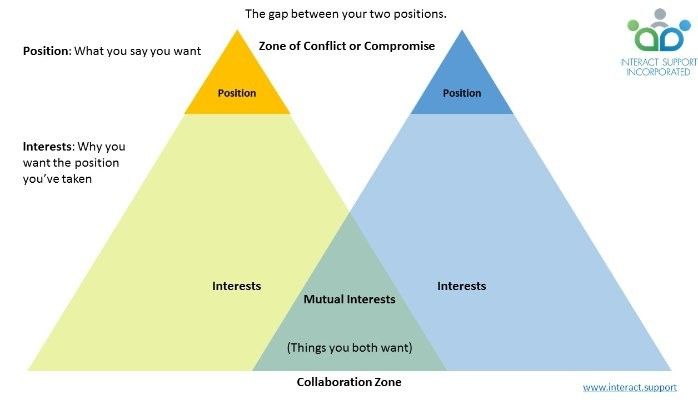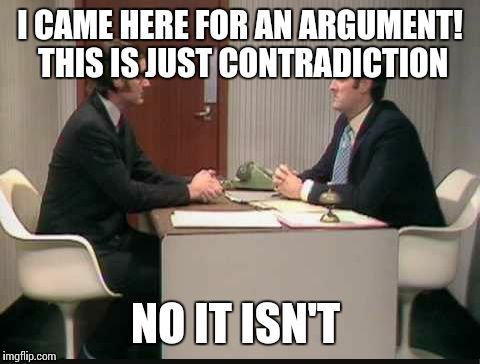Why you get stuck in bad conversations and how to get out of them
The Merlin Works Early Summer 2024 Newsletter
I’ve been finding myself getting stuck in conversations I don’t want to be in. For example, I’ll be at the dinner table sharing a new idea I just learned in a podcast that day, and instead of exploring the idea with my family like I’d hoped, five minutes into the conversation I’m arguing on behalf of an idea I didn’t even know about a few hours ago that I don’t even know if agree with.
I feel like the main character in the Monty Python Argument Sketch. He pays money at the front desk and heads to an assigned room looking for an argument, but the person there only contradicts what he says over and over.
“This isn’t an argument!”
“Yes it is”
“No it isn’t. It’s just contradiction!”
“No it isn’t.”
“Yes it is.”
The customer is frustrated that he’s not getting the conversation he wants, but also can’t seem to escape it either. He continues to contradict the other person, even though he’s more interested in an argument which “is an intellectual process. Contradiction is just the automatic nay-saying of whatever the person says.”
“No it isn’t.”
“Yes it is!”
I end up in unwanted arguments partly because of my audience: two tween boys and a middle aged man, all very smart and who enjoy intellectual disputes in a way I do not. I like harmony, collaboration, and vulnerability.
So I invented a game to play at the dinner table with my family: The Conversation Quiz Game. How it works is I introduce a conversation topic and they have four choices:
- Support: This is when I’m looking for them to cheerlead me on the topic, it’s less about adding ideas and more about adding energy and optimism.
- Explore: This is closer to Yes Anding the idea. If this is true, then what else might be true? Help me think it through.
- Challenge: It’s debate time! Take a position and lay out the supporting arguments.
- Boundary: Let me know that this is not a topic you are up for discussing, maybe just at this time or place or maybe never
I felt like I was always getting option 3: Challenge, so I wanted to play a game to explore other options and see if they could guess what I was looking for or what might be most helpful. Here are some examples with the top answer from my point of view (other answers might be acceptable or better for you, depending on context):
- Example: “I heard they won’t let the students use AI on the STAAR essay test, but the state is using AI to grade them!”
- Answer: 3. Challenge! This is a great topic to debate the pros and cons of Artificial Intelligence in education.
- Example: What do y’all think about going on a cruise next year?
- Answer: 2: Explore! This is not actually an invitation to argue about how terrible cruises are. This is just in the early exploration phase, so we can talk about what kind of cruise, where, for how long, and what might be ideal for each of us.
- Example: “I said I was going to exercise today, but I got caught up at my desk. I’m so mad at myself.”
- Answer: Support! Give some encouragement for me to succeed tomorrow. Remind me of my successes in the past. No need to give me ideas on how to solve the problem or disagree with my statement.
- Example: “I know you said you were stressed about that project, how’s it going?”
- Answer: Boundary: if you just want to relax at dinner, maybe this isn’t the time to talk about a stressful project. Or maybe you just want mom to butt out. You can say that (politely) and we can move on.
This is similar to work I’ve been doing with Research Theory about helping scientists create an environment that supports their creativity. Oftentimes, in academic and scientific settings, people think every conversation is a debate: an opportunity to show off your smarts, poke holes in other arguments, and make progress in the pursuit of the truth. Although there is great value in conversations like that, there’s also a lot of limitation in having all conversations become debates. So we’ve been teaching a tool we’re calling Position vs Exploration Based Conversations.
Round 1:
We have Player A and Player B sit facing each other, which is often the default in most meetings. Then we assign each of them a position on a hot button issue.
Player A’s position is “The internet is ruining society”
Player B’s position is “The internet is saving society”
Then we give them 3 minutes to discuss.
What often happens is people get into a debate, defending a position they may or may not actually believe.
Round 2:
We have Player A and Player B stand side by side, their bodies in alignment, and get ready to have a walk and talk meeting. (This can be adapted to sitting side by side and putting the question on a piece of paper or white board.) Then we give them a question to explore:
“How can the internet best be used to benefit society? ”
The important thing is that their bodies are in alignment, instead of opposition like they were in Round 1, and that the question they are exploring is externalized and is not a position that belongs to any one person in the conversation. Again, give them 3 minutes to have their walk and talk meeting.
Then we come together and have a compare and contrast debrief about how different the experience and results are from Round 1 and Round 2. The difference is usually strong: Round 1 is often combative, unproductive, and emotional. Round 2 is often collaborative, creative, and energizing. Same people, same topic, but the framing creates a totally different conversation. Now people have a tool they can use when they are feeling stuck in an adversarial conversation– switch to a walk and talk meeting. This could be going to the break room together for a cup of coffee or taking a walk around the block. It can even happen on a conference call when you both agree to put on a headset and walk around. The energy and the conversation can shift quickly and clearly.

Of course, the ideal situation is asking for and setting up the conversation you want ahead of time. This can happen in the invitation, meeting agenda, or just in setting the framework at the beginning chat. Something like, “Hey, I’ve got this idea, and I’m just thinking about it, so I’m not really ready for criticism or commitment. Do you think you could just help me think it through a bit?” Often what I say is, “I want to float this idea out there and see what you think.” This is a way for me to explore an idea aloud and get input without being committed to a position or an action.
Lastly, you have to know your audience. Some people are just better for some kinds of conversation. Asking them for something different might just be an uphill battle that’s not worth having. It’s one reason why it’s important to have different people in your life to discuss different topics in different ways. I’ve got my single mamas to complain about co-parenting. I’ve got my improv colleagues to talk shop to. I’ve got my confidants to get vulnerable with, and I’ve got YOU to share all my favorite Applied Improv Ideas with! What other categories of conversation come to mind? What could I add to the list? Let’s explore this idea together!


